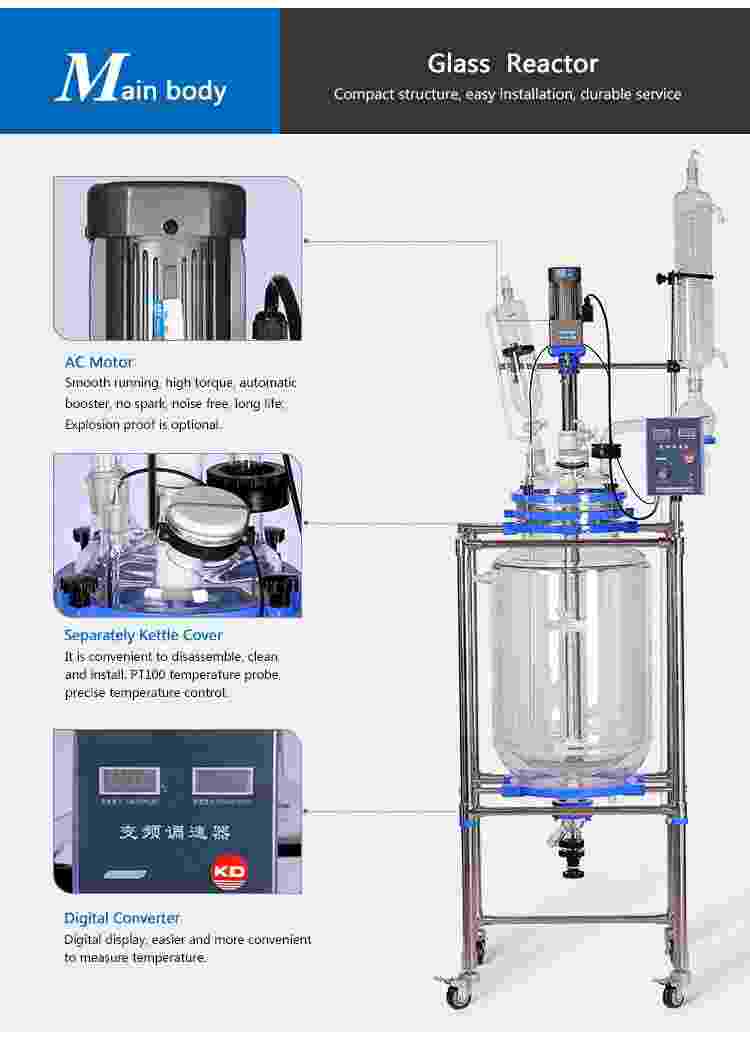How to use glass reactor
The glass reactor can be set at a constant temperature, in a closed glass reactor, can be stirred and reacted under normal pressure or negative pressure according to the requirements of use, and can do the reflux and distillation of the reaction solution. It is a modern fine chemical factory ,Ideal pilot plant and production equipment for biopharmaceutical and new material synthesis.
How to use glass reactor ?
As we all know, the reasonable installation and correct operation of the glass reactor are the prerequisites to ensure the stable operation of the glass reactor. In the working process of the double-layer glass reactor, in fact, some places are very easy to be ignored by users. In this regard, we have made a brief summary based on the experience.
First, pay attention to heat preservation. Due to the small thickness of the interlayer in the middle of the glass reactor, the thermal insulation performance is poor. In the process of using high temperature and low temperature, users need to use insulation materials to protect the kettle body. At the same time, the user needs to wrap the reactor body and the liquid-conducting pipe with insulation materials, and pay attention to the thickness of the insulation layer to ensure a better insulation effect.
Second, the choice of temperature control medium. Generally speaking, users will choose temperature control media of different properties as the heat transfer medium of the reaction according to the required reaction temperature. Choose ethanol bath for low temperature, water bath for normal temperature, and oil bath for high temperature.
When using low or high temperature, pay attention to choosing the right medium, the key is viscosity. "If the viscosity of the medium is too high, the circulating pump may not be able to carry it. The medium circulation effect is not good, and the required temperature control effect cannot be achieved. If the high-power circulating pump is replaced rashly, the pressure of the medium is too high, which may damage the double-layer glass reactor. The lining, the reactor ruptured."
It is understood that usually manufacturers will match the corresponding heating medium for selection according to their products.
Third, the storage location must be reasonable. The double-layer glass reactor is used as a reaction amplification test device. The volume is usually 50-150L, and the volume can be customized under specific circumstances. Therefore, the scale of the test should not be underestimated. Since the kettle body is made of glass, stainless steel is the bracket and the legs are casters, the storage location needs to be carefully selected. In terms of storage conditions, although the casters can be fixed with foot buckles, the stability is not strong. Therefore, the user should pay attention to choosing a flat place during storage, and keep the mechanical stirring center consistent with the reactor, otherwise it is easy to shake and become unstable and cause accidents. In addition, it must be placed in a well-ventilated place.
Fourth, precautions for feeding. Since the double-layer glass reactor is an independent reaction shelf and the reserved feeding port is small, the feeding process is more difficult.
In this regard, the industry suggests that solid reagents can be mixed into a solution and added to the kettle, and liquid reagents can be pumped into the kettle through a matching water pump or oil pump. In particular, to add the reaction material to the reaction kettle through a constant pressure dropping funnel or a common dropping funnel, a corresponding moving ladder is required to allow the staff to add the test material.
In addition, the one-time feeding amount of the glass reactor should not be too large. The user needs to evaluate the reaction temperature, reflux and pressure, and add the appropriate amount of materials, generally not more than 2/3 of the kettle body.


